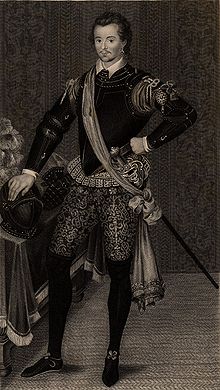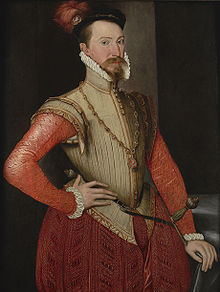- Douglas Sheffield, Baroness Sheffield
-
Douglas Sheffield Baroness Sheffield Spouse(s) John Sheffield, 2nd Baron Sheffield
Sir Edward StaffordIssue Elizabeth Butler, Countess of Ormonde
Edmund Sheffield, 1st Earl of Mulgrave
Sir Robert Dudley (illegitimate)Noble family Howard Father William Howard, 1st Baron Howard of Effingham Mother Margaret Gamage Born 1542/1543 Died 1608
WestminsterDouglas Sheffield (also spelt Douglass), Baroness Sheffield, née Howard, (1542/1543[1] – 1608) was an English noblewoman and the mother of the explorer and cartographer Sir Robert Dudley, illegitimate son of Robert Dudley, 1st Earl of Leicester. Seventeen years after the Earl's death she claimed in a court case that she had been his secret wife, notwithstanding she had herself remarried while Leicester was still alive.
Contents
Family and first marriage
Douglas Howard was the eldest daughter of William Howard, 1st Baron Howard of Effingham and his second wife Margaret Gamage. Douglas Howard was probably named in honour of her godmother Margaret Douglas, Countess of Lennox.[1] One of Douglas Howard's brothers was Lord Admiral Charles Howard of Effingham.[1]
Douglas Howard was at court in c. 1559, probably as a maid of honour.[2] In 1560 she married a wealthy peer, John Sheffield, 2nd Baron Sheffield.[1] They had a son and a daughter: Edmund Sheffield, 1st Earl of Mulgrave, who was born in 1565, and Elizabeth Sheffield, who married Thomas Butler, 10th Earl of Ormonde and died in November 1600.
Love affair
Lady Douglas Sheffield began an affair with Robert Dudley, 1st Earl of Leicester, Queen Elizabeth's favourite, not long after the death of John Lord Sheffield in December 1568.[3] At some point in the following years, Leicester wrote her a remarkable letter,[4] pondering on the history of their love, and explaining to her the reasons why he could not marry, not even to beget a legitimate heir; it would result in his "utter overthrow":[5]
You must think it is some marvellous cause, and toucheth my present state very near, that forceth me thus to be cause almost of the ruin of mine own house ... my brother you see long married and not like to have children, it resteth so now in myself; and yet such occasions is there ... as if I should marry I am sure never to have [the queen's] favour.[6]
He continues, proposing that she accept one of the suitors for her hand, who she had so far declined for his sake: "The choice falls not oft, and yet I know you may have now of the best; and it is not my part to bid you take them ... so it were not mine honesty to bid you refuse them."[7] However, he says, he still loves her as he did in the beginning.[8] Yet he would help her, in case she wanted to marry elsewhere for reasons of respectability: "for when you have made your election you shall find me a most willing and ready friend to perform all good offices toward you".[9] In May 1573, it was observed by the court correspondent, Gilbert Talbot, that the Earl of Leicester was pursued by Lady Douglas and her sister:
There are two sisters now in the court that are very far in love with him, as they have long been; my Lady Sheffield and Frances Howard. They (of like striving who shall love him better) are at great wars together and the queen thinketh not well of them, and not the better of him.[10]
In August 1574, Douglas' son Robert was born. Leicester acknowledged paternity of his "base son",[11] and was very fond of him, caring much for his well-being and education.[12]
It is unclear how long Leicester's affair with Lady Sheffield continued, but nearly thirty years later her version was that Leicester wanted to end the relationship around 1578, before his marriage to Lettice Knollys, the widowed Countess of Essex.[13] They had a meeting at Greenwich in the garden, where according to her later claims, he wanted her to "disavow the marriage", offering her 700 pounds a year.[14] She passionately rejected the offer. Leicester also became furious, saying he could as well part from her, leaving her penniless. Upon some reflection, she accepted the offer at last.[14] Leicester, newly married, kept a portrait of Lady Douglas Sheffield in his country house at Wanstead until his death.[15]
In 1604 Lady Sheffield also claimed that she had refused to surrender the custody of their son, Robert, for fear that his father, the Earl, would have him killed.[16] However, there is no trace of any disagreement over young Robert's upbringing and whereabouts. He grew up in Leicester's and his friends' houses, having "leave to see" his mother whenever she wished.[1]
Second marriage and Star Chamber trial
 Sir Robert Dudley, son of Douglas Sheffield
Sir Robert Dudley, son of Douglas Sheffield
On 29 November 1579 Douglas Sheffield married Sir Edward Stafford,[17] whose mother, Dorothy Stafford, was very influential with the Queen.[18] From 1583 till 1591 Edward Stafford served as English ambassador to the court of Henry III of France; his wife accompanied him to Paris. There Lady Sheffield became a prominent society figure and a special friend of Catherine de' Medici, whom she advised about a reform of the French royal household.[1] By Stafford she had two sons who died young. The ambassador honoured his wife greatly, but had to cope with the fact that she was still emotionally agitated by remembrances of the Earl of Leicester.[19] Stafford was politically opposed to Leicester,[18] the personal component only aggravating this.[20]
After the death of Elizabeth I, in May 1603, Lady Sheffield's son, Sir Robert Dudley, began trying to claim his father's and his uncle's extinct titles of Earl of Leicester and Earl of Warwick. He had been apparently told by a shadowy adventurer called Thomas Drury that his parents had been secretly married.[21] The case ended up in the Star Chamber and aroused great public interest in 1604–1605. The court heard ninety witnesses for Dudley and fifty-seven for Leicester's widow, Lettice Knollys. Lady Sheffield declared in writing (she did not attend the trial personally) that Leicester had solemnly contracted to marry her in Cannon Row, Westminster in 1571, and that they were married at Esher, Surrey, "in wintertime" in 1573. Yet all of the ten putative witnesses ("besides others") to the ceremony were long dead since. Neither could she remember who the "minister" was, nor the exact date of the marriage.[22] As an explanation for marrying Edward Stafford, she asserted that Leicester had tried to poison her and, "life being sweet", she had determined to marry "for safeguard of her life".[23] The Star Chamber rejected the evidence and fined several of the witnesses. It was concluded that Sir Robert Dudley had been duped by Thomas Drury, who in his turn had sought "his own private gains".
Sir Edward Stafford died while the proceedings were in progress.[1] Required to answer questions for the case, he maintained that Dudley had "terrified" his mother into supporting him against her deep reservations.[1] Stafford wrote that he had asked his wife in December 1579, on the Queen's command, if she had been contracted to Leicester, to which "she answered with great vows, grief and passion that she had trusted the said earl too much to have anything to show to constrain him to marry her."[23][note 1]
Douglas Sheffield died in early December 1608 at Westminster.[1] In her will she left a black velvet bed among other things to her "honourable and beloved son Sir Robert Dudley".[25]
Footnotes
- ^ In the 19th century, the question of Sir Robert Dudley's legitimacy was again raised in the House of Lords, but again, it remained unresolved. Historians have had differing views on the problem: While Derek Wilson believes in a marriage,[24] it has been rejected by, for example, Conyers Read,[8] Johanna Rickman,[3] and Simon Adams.[1]
Citations
- ^ a b c d e f g h i j Adams 2008c
- ^ Rickman 2008 p. 49
- ^ a b Rickman 2008 p. 51
- ^ Read 1936 pp. 15–16; Jenkins 2002 p. 186
- ^ Read 1936 p. 25
- ^ Read 1936 pp. 25, 24
- ^ Read 1936 pp. 23–24
- ^ a b Read 1936 p. 23
- ^ Read 1936 p. 26
- ^ Wilson 1981 p. 207
- ^ Warner 1899 p. vi
- ^ Warner 1899 p. vi; Wilson 1981 p. 246
- ^ Adams 2008a
- ^ a b Jenkins 2002 p. 217
- ^ Jenkins 2002 p. 283
- ^ Adams 2008b
- ^ Jenkins 2002 p. 249
- ^ a b Doran 1996 p. 161
- ^ Jenkins 2002 p. 298
- ^ Jenkins 2002 pp. 285–286, 325; Haynes 1992 p. 44
- ^ Warner 1899 p. xli
- ^ Warner 1899 pp. xl–xli
- ^ a b Warner 1899 p. xlv
- ^ Wilson 1981 p. 326
- ^ Warner 1899 p. xlvi
References
- Adams, Simon (2008a): "Dudley, Robert, earl of Leicester (1532/3–1588)" Oxford Dictionary of National Biography online edn. May 2008 (subscription required) Retrieved 2010-04-03
- Adams, Simon (2008b): "Dudley, Sir Robert (1574–1649)" Oxford Dictionary of National Biography online edn. Jan 2008 (subscription required) Retrieved 2010-04-03
- Adams, Simon (2008c): "Sheffield , Douglas, Lady Sheffield (1542/3–1608)" Oxford Dictionary of National Biography online edn. Jan 2008 (subscription required) Retrieved 2010-04-03
- Doran, Susan (1996): Monarchy and Matrimony: The Courtships of Elizabeth I Routledge ISBN 0415119693
- Haynes, Alan (1992): Invisible Power: The Elizabethan Secret Services 1570–1603 Alan Sutton ISBN 0750900377
- Jenkins, Elizabeth (2002): Elizabeth and Leicester The Phoenix Press ISBN 1842125605
- Read, Conyers (1936): A Letter from Robert, Earl of Leicester, to a Lady The Huntington Library Bulletin No.9 April 1936
- Rickman, Johanna (2008): Love, Lust, and License in Early Modern England: Illicit Sex and the Nobility Ashgate Publishing ISBN 0754661350
- Warner, G.F (1899): The Voyage of Robert Dudley to the West Indies, 1594–1595 Hakluyt Society
- Wilson, Derek (1981): Sweet Robin: A Biography of Robert Dudley Earl of Leicester 1533–1588 Hamish Hamilton ISBN 0241101492
Categories:- 1540s births
- 1608 deaths
- Women of the Tudor period
- Women of the Stuart period
- British baronesses
- 16th-century women
- English women
- 16th-century English people
- 17th-century women
- 17th-century English people
- Sheffield family
- Howard family (English aristocracy)
Wikimedia Foundation. 2010.

